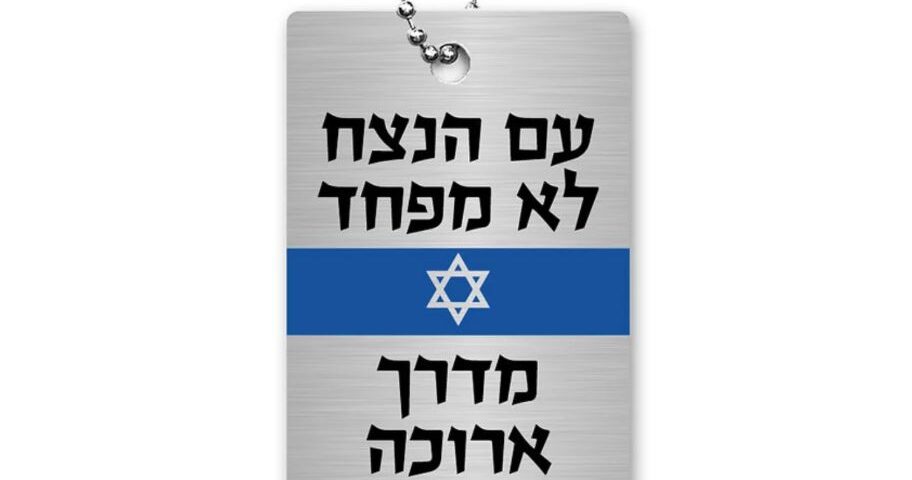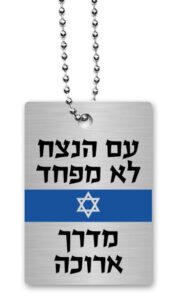TRADITION Questions: The New “New Jew”

 Click here to read about this series.
Click here to read about this series.
What is it?
The Jewish people has been called many things throughout its long history. Likewise, we have referred to ourselves by many different names. A new name for our nation has recently gained popularity in divrei Torah, music, and politics. In a July 2014 Arutz 7 interview, Rabbi Yehoshua Weitzman (Rosh Yeshivat Maalot) describes the origin of the phrase that he had coined: “The eternal people does not fear a long journey” (עם הנצח לא מפחד מדרך ארוכה).
In the interview, he describes how he drew the am ha-netzah phrase from two sources within the writing of Rav Kook and how it projects confidence in challenging times. He said, “The Jewish nation has great fortitude and purpose, allowing it to endure a long wait for its potential to be realized.”
There is a certain irony in the fact that “the eternal people” is a “new” name for the eternal people. This irony becomes even more significant in light of the history of an early Zionist concept, the “New Jew.” The movement sought not only to develop the Land of Israel but also to develop a new and modern Jewish person. This new Jew would replace the weak, pale, timid, scared Diaspora Jew. The new Zionist Jew would be strong, confident, and effective. Working the land would develop the Jewish psyche and person. Yet, the term “New Jew” has now been eclipsed by the “Eternal People.” Israeli identity has begun to reintegrate into the everlasting Jewish identity. The term am ha-netzah draws a link between the Diaspora and the New Jew within a common thread of both history and destiny.
Rabbi Jonathan Sacks also made use of the sobriquet “eternal people” in his writing. In contrast with R. Weitzman’s sourcing the term within Rav Kook, R. Sacks locates this concept in Pascal:
Whereas the peoples of Greece and Italy, Sparta, Athens, and Rome, and others who came much later, have perished so long ago, the Jews still exist, despite the efforts of so many powerful kings who have tried a hundred times to wipe them out, as their historians testify and as can easily be judged by the natural course of events over so long a period. They have always been preserved, and their preservation was foretold (Pensées, Fragment 739).
Mark Twain famously made a similar point in a Harper’s Magazine essay, “Concerning the Jews” (1899):
The Egyptian, the Babylonian, and the Persian rose, filled the planet with sound and splendor, then faded to dream-stuff and passed away; the Greek and the Roman followed, and made a vast noise, and they are gone; other peoples have sprung up and held their torch high for a time, but it burned out, and they sit in twilight now, or have vanished. The Jew saw them all, beat them all, and is now what he always was, exhibiting no decadence, no infirmities of age, no weakening of his parts, no slowing of his energies, no dulling of his alert and aggressive mind. All things are mortal but the Jew; all other forces pass, but he remains. What is the secret of his immortality?
Why does it matter?
Carmi Fuchs and Shmuel Rosner wrote of a blended Israeli-Jewish Identity in their study, #IsraeliJudaism: Portrait of a Cultural Revolution (JPPI, 2019). They describe traditional Jewish practices and modern nationalistic elements creating a new political force within Israeli society. This hybrid identity reflects a society where secular and religious lines blur, and where national experiences—like military service and state holidays—are integral to Jewish life. Whereas the book underscores that this form of Judaism, distinct from Diaspora and pre-State versions, is deeply rooted in Israel’s unique societal context, the “Eternal People” idea suggests a reimagining of Israeli identity within the larger story of Jewish identity.
On the cover of his recent Hebrew book, A Tale of a Tzaddik and a Stretcher (Yediot), Chaim Navon refers to the current war as Milhemet Shmini Atzeret. While Shmini Atzeret and Simchat Torah are combined into one day in Israel, the focus culturally and publicly—in schools, media, and common speech—is on Simchat Torah, the joyful celebration of finishing and restarting the Torah reading cycle. Navon nevertheless borrows this biblical term (preserved in Diaspora religious life and culture) to refer to what is generally called in Israel Milhemet Harvot HaBarzel or the October 7th War. This revivification of the Shmini Atzeret term ties Israeli life to Diaspora religious culture and the longer arch of Jewish history. It situates the war within Judaism and the tradition of Chasidic stories and classic Jewish martyrdom.
In 2021, public broadcaster Kan 11 showed an Israeli documentary series called “The New Jew.” The program profiled North American Jews challenging the Zionist stereotypes of the Diaspora Jew. It suggests that in some respects America has incubated an even new-er Jew who thrives in ways that Israeli Jews do not. Has the am ha-netzah idea changed how Israeli Jews see Jews in the Diaspora? Does it make acceptance of the Diaspora Jew and her Judaism more or less likely?
What questions remain?
How does an “Eternal People” mindset affect personal and political decisions within Israel and the Diaspora? How does it affect the relationship between Jews in Israel and Jewish communities around the world?
How has the meaning of this phrase changed since it first became popular during the hitnatkut – the 2005 disengagement from Gaza? How has the meaning changed since October 7?
Chaim Strauchler, rabbi of Rinat Yisrael in Teaneck, is an Associate Editor of TRADITION.
